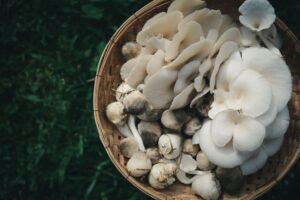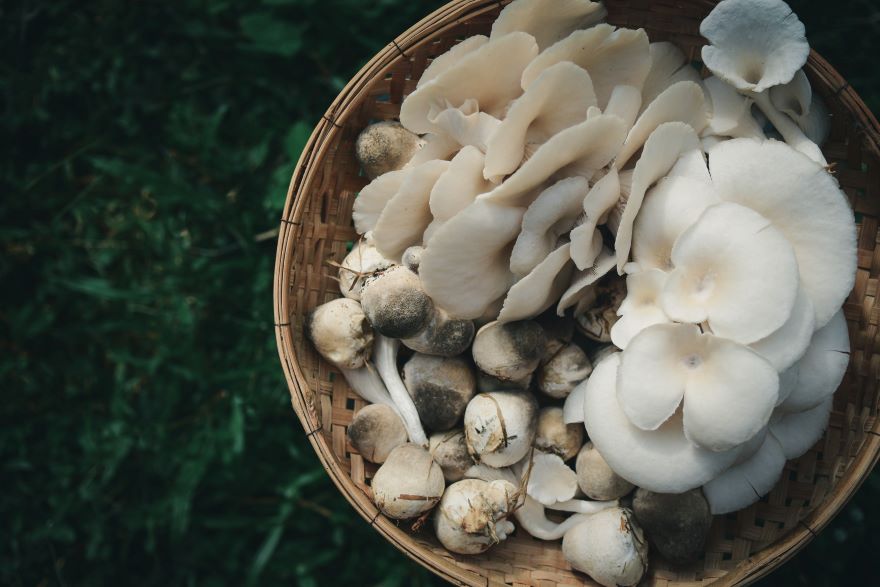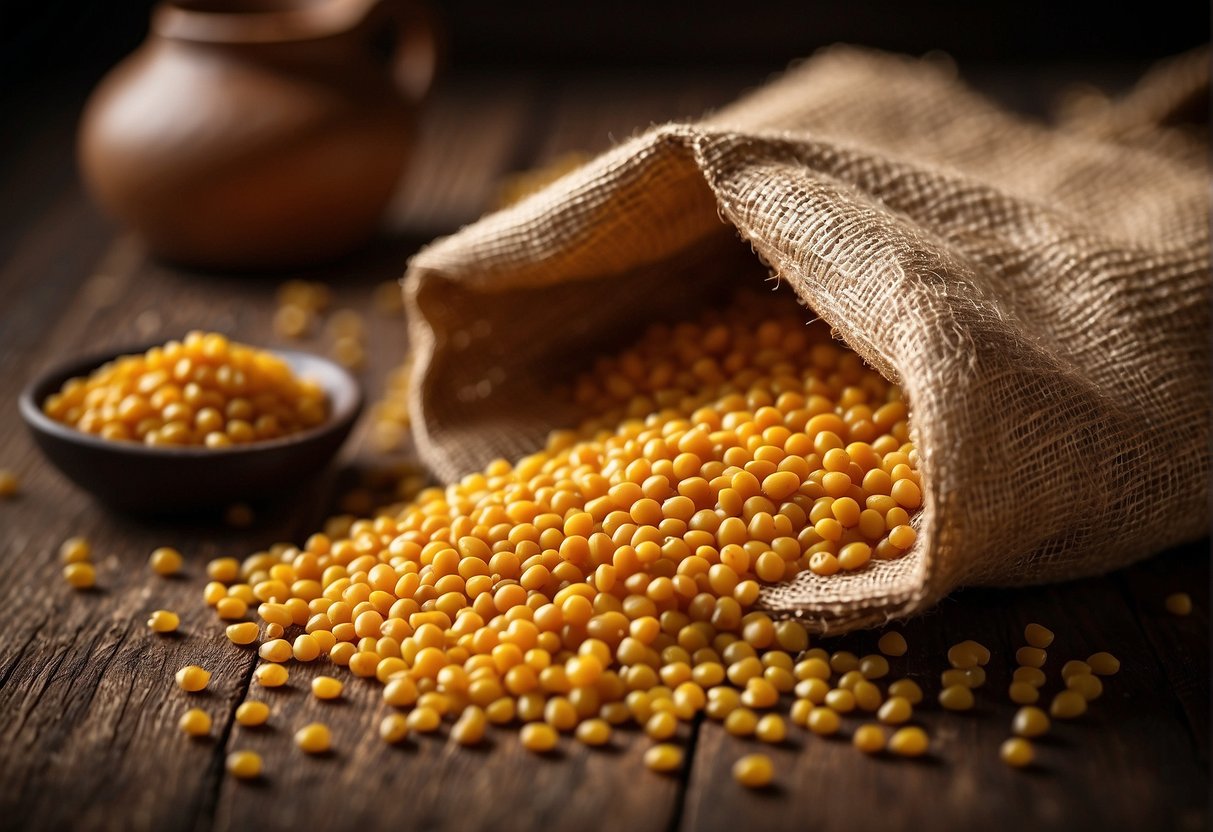Straw mushrooms, scientifically known as Volvariella volvacea, are a type of edible mushroom native to East and Southeast Asia. They play an important role in Asian cuisine, adding a distinctive flavor and texture to a variety of dishes. They can be found in both fresh and canned varieties, and are cultivated on rice straw, which gives them their name.

These mushrooms are not only appreciated for their taste but also their nutritional value. Rich in vitamins and minerals, they offer a number of health benefits when consumed as part of a balanced diet. The cultivation of straw mushrooms at home is becoming increasingly popular, as it is a rewarding and sustainable means of producing your own supply.
Key Takeaways
- Straw mushrooms are a flavorful and nutritious addition to Southeast Asian cuisine
- They offer various health benefits and can be cultivated at home
- Caution is advised when foraging for wild mushrooms to avoid toxic species
The Unique Qualities of Straw Mushrooms

Physical Characteristics
Straw mushrooms, also known as Volvariella volvacea, have some distinct physical features that make them stand out among other mushroom varieties. These mushrooms have oval to round-shaped caps, usually measuring 2-5 cm in diameter. Initially, they are pink and turn to grey-brown as they mature. The cap is equipped with a small volva at its base, which further aids in identification. Their smooth and silky texture is not only visually appealing but also contributes to their overall culinary quality.
Nutritional Profile
The nutritional content of straw mushrooms is quite impressive, considering their relatively small size. They are a good source of protein and fiber, making them a healthy and nutritious addition to any meal. Furthermore, they contain essential amino acids, which play a crucial role in promoting overall health and wellness. Raw straw mushrooms are low in calories, allowing you to enjoy their intense flavor without having to feel guilty about any excess calories.
| Nutrient | Amount (per 100 g) |
|---|---|
| Calories | 35 kcal |
| Protein | 4.3 g |
| Fiber | 1.3 g |
| Amino Acids | Various |
Varieties and Culinary Uses
There are different varieties of straw mushrooms, each with its own unique flavor and texture profile. In my experience, the pink variety is tender and has a more subtle flavor, while the more mature grey-brown sort tends to have a firmer texture and a more robust flavor profile. I find that these differences can make a significant impact on the various dishes I prepare with straw mushrooms.
Due to their versatile nature, straw mushrooms can be used in a wide range of culinary masterpieces, including stir-fries, soups, salads, and more. Their delicate texture adds an interesting contrast to heavier ingredients, while their intense flavor complements and enhances the flavors of other ingredients in the dish. Personally, I enjoy incorporating straw mushrooms in classic Asian recipes such as Tom Yum soup or a simple vegetable stir-fry.
How to Cultivate Straw Mushrooms at Home
Selecting the Right Spawn
In my experience, the first step in growing straw mushrooms at home is selecting the right spawn. It’s crucial to choose a high-quality mushroom spawn to ensure successful cultivation and a bountiful fruiting. Log cultivated strains are a popular choice for home growers, as they tend to be more resistant to contamination and produce a more consistent yield.
Preparing the Substrate
Next, I prepare the substrate, which provides the necessary nutrients for the mushroom mycelium to grow. A common substrate for straw mushrooms is rice straw, which offers an ideal environment for the mycelium to colonize. To prepare the substrate:
- Chop the rice straw into pieces of around 10cm in length.
- Perform pasteurization to kill unwanted microbes and reduce contamination risk. This can be done either by submerging the straw in hot water (70-80° C) for 50-60 minutes, or via chemical pasteurization using a diluted lime solution.
- Once pasteurized, allow the straw to cool down and drain any excess water.
Tip: Be sure the substrate is not too wet, as overly moist conditions can encourage contamination and inhibit mycelial growth.
Maintaining Proper Conditions
After preparing the substrate, I mix in the chosen mushroom spawn and pack the mixture into a suitable growing container, such as a plastic bag or a small log. Then, I place the container in a dark, warm location at around 25-30° C to encourage colonization.
As the mycelium colonizes the substrate, it’s important to maintain proper conditions for optimal growth and fruiting. This includes:
- Ensuring the substrate remains moist by occasionally misting with water.
- Maintaining good ventilation in the growing area to prevent excess humidity and stagnation.
- Keeping the growing area clean and free of potential contaminants.
Once the mycelium has fully colonized the substrate, you can expect to see fruiting bodies – the part of the mushroom that we eat – emerging within a few weeks. At this stage, it’s crucial to continue monitoring and maintaining the ideal growing conditions to ensure a successful and bountiful harvest.
By following these steps and remaining vigilant regarding potential contamination, I’ve consistently produced healthy and delicious straw mushrooms right at home!
Health Benefits of Straw Mushrooms
Vitamins and Minerals
One of the important health benefits of straw mushrooms is their rich vitamin and mineral content. As a source of iron, copper, phosphorus, zinc, and selenium, these fungi play a crucial role in boosting our immune system. I also appreciate that they are a good source of B-vitamins, promoting healthy cellular function.
Antioxidant Properties
Antioxidants are essential for our body as they protect us from harmful free radicals. Straw mushrooms offer a low-calorie source of antioxidants that help improve our overall health. Some of the key antioxidants found in straw mushrooms, such as limonene and octa-1,5-dien-3-ol, contribute to their unique flavor profile as well.
Dietary Fiber and Weight Management
Another reason I value including straw mushrooms in my diet is due to their high dietary fiber content. This aids in weight management, as fiber-rich foods help with satiety, making us feel full longer. Hence, it’s a great low-calorie option containing protein and fiber that I often recommend to those looking for healthy food alternatives.
Incorporating straw mushrooms into our diet is a delicious way to benefit from their nutritional properties. As I’ve mentioned, these mushrooms are packed with essential vitamins, minerals, antioxidants, and dietary fiber. So, next time you’re looking to boost your immune system, support weight management, or simply enjoy a tasty and nutritious meal, consider adding straw mushrooms to your recipe.
Incorporating Straw Mushrooms into Your Diet
Recipes and Ideas
As someone who enjoys exploring different ingredients, Straw mushrooms can be a delightful addition to my diet. They are versatile and can be included in various dishes. One of my favorites is adding them to stir-fries. I simply toss in sliced straw mushrooms with my choice of protein and vegetables, giving the dish a unique, earthy flavor.
Soups and stews are other excellent options for incorporating straw mushrooms into my meals. They provide a delightful textural contrast while absorbing the flavors of the dish. I also enjoy adding the mushrooms to my salads for an extra layer of flavor and texture.
Preservation and Storage Tips
To make the most of these nutritious fungi, I’ve learned some effective preservation and storage techniques. When I buy fresh straw mushrooms, I store them in the refrigerator inside a paper bag to maintain their quality. This method helps regulate moisture and prevents them from becoming slimy or moldy.
For longer storage, there are two main methods I use:
- Canned Straw Mushrooms: Canning is an excellent way to preserve mushrooms and enjoy them in various dishes throughout the year. I can also find high-quality canned straw mushrooms in most grocery stores, which is a convenient option.
- Dried Straw Mushrooms: Drying is another excellent preservation method, allowing me to keep them in my pantry for extended periods. Dried mushrooms can readily be rehydrated by soaking them in water before use.
By following these preservation and storage tips, I can ensure that straw mushrooms are a regular, delicious component of my meals.
Potential Risks and Considerations

Distinguishing Edible Varieties
When it comes to cultivating and consuming straw mushrooms, there are potential risks if you don’t properly distinguish edible varieties from their toxic counterparts. Please be cautious as some poisonous mushrooms, such as death cap mushrooms, closely resemble straw mushrooms. To ensure edible variety identification, I recommend using a spore print technique. An edible straw mushroom will leave a pink spore print, whereas the toxic death caps produce a white spore print. While Agaricus bisporus is not toxic, it’s essential to recognize the difference between the various mushroom species for your safety.
Storage and Consumption Safety
Straw mushrooms are delicate and require proper storage to maintain their quality and avoid any health risks. Here are some storage tips to keep your mushrooms safe for consumption:
- Store them in a paper bag or a porous container to allow air circulation.
- Keep them dry and avoid sealing in airtight containers, as moisture leads to spoilage.
- Consume within 3 to 5 days, as these mushrooms have a relatively short shelf life.
In addition to storage, proper cooking is essential for safety when consuming straw mushrooms. Cooking helps eliminate potential contaminants, so I advise you to thoroughly cook your mushrooms before consuming them.
Allergy Information
As with any food, individual allergies to straw mushrooms might occur. If you’re unsure whether you are allergic, it’s best to consume a small amount initially and observe for any adverse reactions. Symptoms of a mushroom allergy may include:
- Skin irritation (rash, itching, or hives)
- Respiratory issues (coughing, wheezing, or difficulty breathing)
- Digestive problems (nausea, vomiting, or diarrhea)
If you experience any of these symptoms after consuming straw mushrooms, cease consumption, and consult a medical professional. Remember, the key to safely enjoying these mushrooms is proper identification, storage, cooking, and being mindful of your body’s reactions.
Frequently Asked Questions
What can I use as a substitute for straw mushrooms in recipes?
If you are unable to find straw mushrooms, there are other alternatives that can provide a similar texture and flavor. For instance, you could use white button mushrooms, cremini mushrooms, or shiitake mushrooms. In my experience, these mushrooms hold up well in a variety of dishes and can easily be substituted for straw mushrooms.
How can I prepare a dish using canned straw mushrooms?
When using canned straw mushrooms, I always make sure to drain them thoroughly to remove excess liquid. After draining, I rinse the mushrooms with cold water to get rid of any possible preservatives. You can then add them to your favorite recipes, such as stir-fries, soups, and pasta dishes. Simply cook them as you would other mushroom varieties, allowing enough time to absorb the flavors of your dish.
What are the nutritional benefits of straw mushrooms compared to other mushroom varieties?
Straw mushrooms, like other mushroom varieties, are a low-calorie, nutrient-dense food. They are rich in antioxidants and contain compounds like beta-glucans, which support immune system function. In comparison to other mushroom types, straw mushrooms also contain a decent amount of protein and fiber, making them a healthy addition to your diet.
What techniques are effective for growing paddy straw mushrooms at home?
One way to grow paddy straw mushrooms at home is to use a prepared growing mix, which can be created by pasteurizing a combination of chopped straw and wheat bran. A helpful guide that I have used is this step-by-step method to grow mushrooms on a straw substrate. Make sure to keep the growing environment clean and monitor the moisture levels to avoid contamination.
What are the culinary uses of peeled straw mushrooms?
Peeled mushrooms are quite versatile in the kitchen. I have used them in various dishes such as stir-fries, curries, soups, and even sauteed on their own with some garlic and butter. Their mild, nutty flavor and delicate texture make them a great addition to a wide range of recipes.
Are there any health concerns associated with consuming paddy straw mushrooms?
As with any food, consuming paddy straw mushrooms in moderation is essential. It is crucial to properly identify the mushrooms, as there are some toxic look-alikes. Additionally, ensure that home-grown or wild-harvested mushrooms are free of contaminants and have been grown or sourced from a reputable supplier.

*We may earn a commission for purchases made using our links. Please see our disclosure to learn more.



